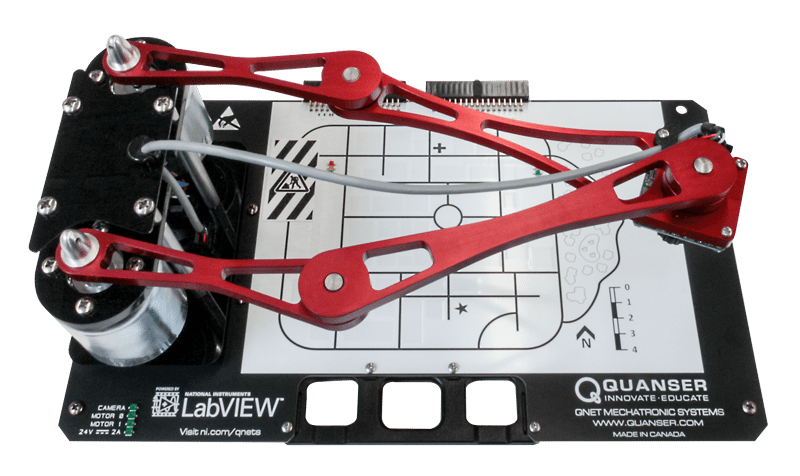ELVIS
NI ELVIS is a project-based learning solution that combines instrumentation, embedded design, and web connectivity for engineering fundamentals and system design. It provides a comprehensive teaching solution for engaging students in hands-on labs involving analog circuits, mechatronics, power electronics, instrumentation, digital communications, digital electronics, controls, and more.


NI ELVIS III
- Software includes interactive web and desktop software front panels, instrumentation support for Windows and Mac, API support for LabVIEW and text-based languages, shipping examples, and detailed help files.
- Seven hardware instruments plus control I/O containing 16AI, 4AO, and 40 DIO.
- 4 Channel, 100MS/s (400MS/s single channel), 50MHz oscilloscope with 14-bit resolution.
- 16 Channel, 100MS/s logic analyzer/pattern generator
- 16 Channel, 1MS/s analog input with 16-bit resolution
- 40 DIO lines individually programmable as input, output, PWM, or digital protocols.
ELVIS II+ |
ELVIS III |
|
| Oscilloscope | 2 Ch, 100MS/s, 8-bits | 4 Ch, 400MS/s, 14-bits |
| Function Generator | 1 Ch, 5MHz, 10-bits | 2 Ch, 100MS/s, 15MHz, 14-bits |
| Logic Analyzer / Pattern Generator | – | 16 Ch, 100MS/s |
| IV Analyzer | – | ±10 V, ±30 mA, 15 MHz |
| Digital Multimeter | 5½ digits | 4½ digits |
| Variable Power Supply | ±12 V, 500 mA | ±15 V, 500 mA |
| Processor FPGA | – | Xilinx Zynq-7020 |
| Analog Inputs | 16 Ch, 16 bits | 16 Ch, 16 bits |
| Analog Outputs | 2 Ch, 16-bits | 4 Ch, 16 bits |
| DIO | 24 DIO, 15PFI | 40 Ch |
| SFP Support | Windows | Windows, Mac & Web |
| Programming Language support | LabVIEW | LabVIEW, Python, C, Simulink |

Quanser Mechatronics Systems Board for NI ELVIS III
The Quanser Mechatronic Systems Board is designed to provide hands-on experience with a complete mechatronic system in a safe, and academically appropriate setting. The board gives students an opportunity to delve into the operation of a mechatronic system at every level, from motor interfacing all the way to an engaging application context using industry-grade instrumentation and real-time control.
- Complete System: A complete mechatronic system from sensor integration and motor control to image processing and state machines
- Open and Customizable: Access and customize all levels of the interfacing and control software using LabVIEW
- Accelerate Discovery: Learn the fundamentals of interfacing, manipulator control, image processing, and state machines
- Comprehensive Courseware: Includes fully customizable ABET-aligned workbooks, software, and additional resources
- Courseware
- Goal-directed line following
- Image processing
- Image tresholding
- Blob detection
- Pattern matching
- State machines
- Manipulator control
- PWM generation
- Encoder decoding
- Inverse kinematics
- Forward kinematics
- PID position control
Quanser Control Board
The Quanser Controls Board offers a complete package for studying fundamental and advanced controls topics. The skills and hands-on experiences gained using the controls board are directly applicable to the challenges engineers face creating the complex systems that dominate the world today.
Features
- Highly Linear Motor Response: To enable directly relational modelling and control design
- Open and Customizable: Access and customize all levels of the interfacing and control software using LabVIEW
- Complete Package: Hardware and courseware enable courses to cover the essentials of introductory and advanced controls
Courseware
- DC Motor Modeling: First principles, experimental, frequency
- Speed Control: PID control, lead compensators
- Position Control: PID control, steady-state error
- Stability: BIBO, Nyquist, Routh Hurwitz
- Inverted Pendulum Control: Pole placement, LQR, swing-up
- Digital Control: Quantization, matched pole-zero, digital design


TI Power Electronics Board for NI ELVIS III
- The board is comprised of four independent sections that are the basic building blocks for understanding the functions of components used in power electronic systems and relevant applications.
- Linear Regulator operation ( Discrete Linear Section)
- Buck Regulator operation (Discrete Buck Section)
- Pulse-Width Modulated Inverter, Square-wave Inverter and High-Frequency Transformer operation ( DC-AC Inverter Section)
- Diode-Bridge Rectifier and Post-Regulator operation ( AC-DC Rectifier section).
- On-board jumpers enable testing with different system configurations
- Test points on board allow measurement of voltage and current.

